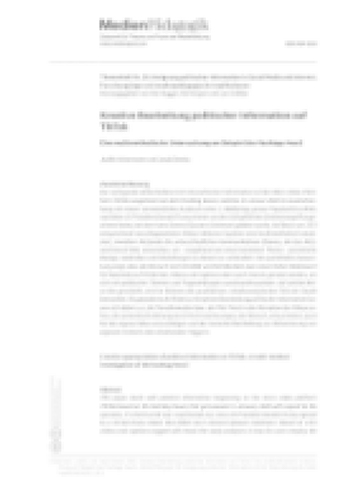Abstract
Open Educational Resources (OER) versprechen einerseits den Abbau von Hürden im Bildungszugang und andererseits die Vermeidung redundanter Arbeit bei der Erstellung ähnlicher und gleichzeitig qualitativ hochwertiger Bildungsressourcen in unterschiedlichen Organisationen. Der Verbreitung von OER stehen jedoch bekannte Hürden gegenüber, wobei das ALMS-Framework einen Rahmen für die Bewertung der Wieder- und Weiternutzung von OER aus technischer Sicht bereitstellt. Ausgehend von einem Selbstversuch zur OER-Einführung werden in dieser Arbeit das ALMS-Framework erweiternde Anforderungen an OER basierend auf Konzepten aus Software-Entwicklung und technischem Schreiben definiert. Unter Beachtung dieser Anforderungen werden zwei OER-Projekte beschrieben: Zum einen wird die Weiterentwicklung eines Lehrbuchs unter Creative-Commons-Lizenz skizziert. Zum anderen werden Erstellung und Nutzung der neu entwickelten Software emacs-reveal für die Erzeugung von für das Selbststudium geeigneten, mit Audiokommentaren unterlegten HTML-Präsentationen beschrieben; die Präsentationen werden in einfachen Textdateien erstellt, wobei die Erzeugung von HTML-Code automatisiert in einer öffentlichen GitLab-Infrastruktur abläuft und damit die Software-Nutzung vereinfacht. Ergebnisse einer Umfrage unter Studierenden verdeutlichen die Vorzüge der erzeugten Präsentationen.
Literatur
Andrade, António, et al. 2011. «Beyond OER: Shifting focus to open educational practices». Open Educational Quality Initiative (OPAL). https://oerknowledgecloud.org/sites/oerknowledgecloud.org/files/OPAL2011.pdf.
Atkins, Daniel E., John Seely Brown, und Allen L. Hammond. 2007. «A Review of the Open Educational Resources (OER) Movement: Achievements, Challenges, and New Opportunities». Report to The William; Flora Hewlett Foundation. http://www.oerderves.org/wp_content/uploads/2007/03/a_review_of_the_open_educational_resources_oer_movement_final.pdf.
Auer, Sören, Ali Khalili, und Darya Tarasowa. 2013. «Crowd-sourced Open Courseware Authoring with SlideWiki.org». International Journal of Emerging Technologies in Learning (IJET) 8 (1): 62–63. https://doi.org/10.3991/ijet.v8i1.2539.
Bishop, Jacob Lowell, und Matthew A. Verleger. 2013. «The flipped classroom: A survey of the research». In 2013 ASEE Annual Conference & Exposition, 1–18. https://peer.asee.org/22585.
Chacon, Scott, und Ben Straub. 2014. Pro Git. 2. Apress. https://doi.org/10.1007/978-1-4842-0076-6.
Ehlers, Ulf-Daniel. 2011. «Extending the territory: From open educational resources to open educational practices». Journal of Open Flexible and Distance Learning 15 (2): 1–10. http://www.jofdl.nz/index.php/JOFDL/article/view/64.
Feller, Joseph, Brian Fitzgerald, Scott A. Hissam, und Karim R. Lakhani, Hrsg. 2005. Perspectives on Free and Open Source Software. MIT Press.
Glushko, Robert J. 2015. «Collaborative Authoring, Evolution, and Personalization for a Transdisciplinary Textbook». In Companion to the Proceedings of the 11th International Symposium on Open Collaboration, 10:1–10:10. https:// doi.org/10.1145/2789853.2789867.
Hailperin, Max. 2016. Operating Systems and Middleware – Supporting Controlled Interaction. Revised edition 1.2.1.
Hailperin, Max. 2017. Operating Systems and Middleware – Supporting Controlled Interaction. Revised edition 1.3. https://gustavus.edu/mcs/max/os-book/.
Hefferon, Jim, und Albert Schueller. 2016. «Writing an Open Text». The Mathematical Intelligencer 38 (2). Springer: 6–9. https://doi.org/10.1007/s00283-015-9606-1.
Hilton, John III, David Wiley, Jared Stein, und Aaron Johnson. 2010. «The four ‘R’s of openness and ALMS analysis: frameworks for open educational resources». Open Learning 25 (1). Taylor & Francis: 37–44. https://doi.org/10.1080/02680510903482132.
Jung, Insung, Teruyoshi Sasaki, und Colin Latchem. 2016. «A framework for assessing fitness for purpose in open educational resources». International Journal of Educational Technology in Higher Education 13 (1). https://doi.org/10.1186/s41239-016-0002-5.
Kerres, Michael, und Richard Heinen. 2014. «Open Educational Resources und schulisches Lernen: Das Zusammenwirken von Plattformen für Lernressourcen in informationell offenen Ökosystemen». In MEDIEN – WISSEN – BILDUNG: Freie Bildungsmedien und Digitale Archive, Petra Missomelius, Wolfgang Sützl, Theo Hug, Petra Grell, und Rudolf Kammerl (Hrsg.), 189–210. innsbruck university press. https://www.uibk.ac.at/iup/buch_pdfs/freie-bildungsmedien_web.pdf.
McGee, Monnie, Lynne Stokes, und Pavel Nadolsky. 2016. «Just-in-Time Teaching in Statistics Classrooms». Journal of Statistics Education 24 (1): 16–26. https://doi.org/10.1080/10691898.2016.1158023.
Merkel, Dirk. 2014. «Docker: Lightweight Linux Containers for Consistent Development and Deployment». Linux Journal. 2014 (239). Houston, TX: Belltown Media.
Mruck, Katja, Günter Mey, Sandra Schön, Heiko Idensen, und Peter Purgathofer. 2013. «Offene Lehr- und Forschungsressourcen. Open Access und Open Educational Resources». In L3T. Lehrbuch für Lernen und Lehren mit Technologien, herausgegeben von Martin Ebner und Sandra Schön, 2. Auflage. epubli. https://l3t.tugraz.at/index.php/LehrbuchEbner10/article/view/112.
Novak, Gregor M., Evelyn T. Patterson, Andrew Gavrin, und Wolfgang Christian. 1999. Just-in-Time Teaching: Blending Active Learning and Web Technology. Prentice Hall.
Rockley, Ann. 2001. «The Impact of Single Sourcing and Technology». Technical Communication 48 (2). Society for Technical Communication: 189–93. http://rockley.com/articles/Single_Sourcing_and_Technology.pdf.
Schulte, Eric, und Dan Davison. 2011. «Active Documents with Org-Mode». Computing in Science & Engineering 13 (3): 66–73. https://doi.org/10.1109/MCSE.2011.41.
Shaffer, Clifford A., Thomas L. Naps, und Eric Fouh. 2011. «Truly Interactive Textbooks for Computer Science Education». In Proceedings of the Sixth Program Visualization Workshop, 97–103. https://people.cs.vt.edu/shaffer/Papers/pvw1.pdf.
Siddhi, Desai, Jashin M. Verghese, und Desai Bhavik. 2017. «Survey on Various Methods of Text to Speech Synthesis». International Journal of Computer Applications 165 (6). https://doi.org/10.5120/ijca2017913891.
Stallman, Richard M. 1986. «What Is the Free Software Foundation?». GNU’s Bulletin 1 (1). https://www.gnu.org/bulletins/bull11.html#SEC4.
Thorogood, Miles. 2016. «slideDeck.Js: A Platform for Generating Accessible and Interactive Web-Based Course Content». In Proceedings of the 21st Western Canadian Conference on Computing Education, 13:1–:5. WCCCE’16. New York, NY, USA: ACM. https://doi.org/10.1145/2910925.2910941.
Vukovic, Boris, und Claude Martin. 2009. «Free and open source software (FOSS) and OER: Part I – An introductory note». In Open Educational Resources: Conversations in Cyberspace. UNESCO Publishing, 105-124. https://unesdoc.unesco.org/ark:/48223/pf0000181682.
Wiley, David. 2014. «The Access Compromise and the 5th R». https://opencontent.org/blog/archives/3221.
Zentrum für Hochschuldidaktik (DiZ), ed. 2016. «DiNa 12/2016». https://diz-bayern.de/publikationen/dina/360-2016-dezember-hd-mint-sonderausgabe-wege-zum-verstaendnis-bauen.

